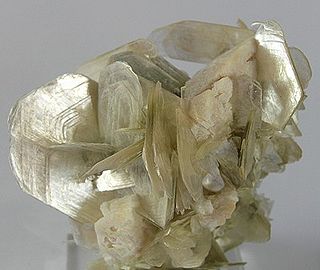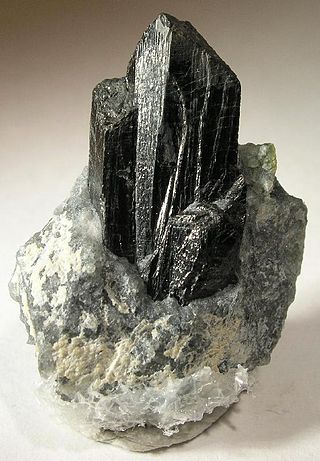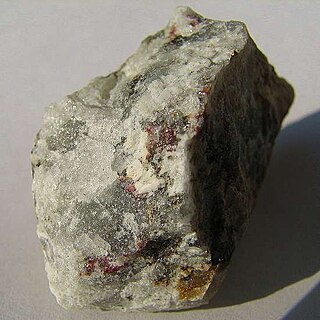
In geology and mineralogy, a mineral or mineral species is, broadly speaking, a solid substance with a fairly well-defined chemical composition and a specific crystal structure that occurs naturally in pure form.

Muscovite (also known as common mica, isinglass, or potash mica) is a hydrated phyllosilicate mineral of aluminium and potassium with formula KAl2(AlSi3O10)(F,OH)2, or (KF)2(Al2O3)3(SiO2)6(H2O). It has a highly perfect basal cleavage yielding remarkably thin laminae (sheets) which are often highly elastic. Sheets of muscovite 5 meters × 3 meters (16.5 feet × 10 feet) have been found in Nellore, India.

Baddeleyite is a rare zirconium oxide mineral (ZrO2 or zirconia), occurring in a variety of monoclinic prismatic crystal forms. It is transparent to translucent, has high indices of refraction, and ranges from colorless to yellow, green, and dark brown. See etymology below.

Silicate minerals are rock-forming minerals made up of silicate groups. They are the largest and most important class of minerals and make up approximately 90 percent of Earth's crust.

Natrolite is a tectosilicate mineral species belonging to the zeolite group. It is a hydrated sodium and aluminium silicate with the formula Na2Al2Si3O10·2H2O. The type locality is Hohentwiel, Hegau, Germany.

Sperrylite is a platinum arsenide mineral with the chemical formula PtAs2 and is an opaque metallic tin white mineral which crystallizes in the isometric system with the pyrite group structure. It forms cubic, octahedral or pyritohedral crystals in addition to massive and reniform habits. It has a Mohs hardness of 6–7 and a very high specific gravity of 10.6.

Celsian is an uncommon feldspar mineral, barium aluminosilicate, BaAl2Si2O8. The mineral occurs in contact metamorphic rocks with significant barium content. Its crystal system is monoclinic, and it is white, yellow, or transparent in appearance. In pure form, it is transparent. Synthetic barium aluminosilicate is used as a ceramic in dental fillings and other applications.

Abenakiite-(Ce) is a mineral of sodium, cerium, neodymium, lanthanum, praseodymium, thorium, samarium, oxygen, sulfur, carbon, phosphorus, and silicon with a chemical formula Na26Ce6(SiO3)6(PO4)6(CO3)6(S4+O2)O. The silicate groups may be given as the cyclic Si6O18 grouping. The mineral is named after the Abenaki, an Algonquian Indian tribe of New England. Its Mohs scale rating is 4 to 5.

Afghanite, (Na,K)22Ca10[Si24Al24O96](SO4)6Cl6, is a hydrous sodium, calcium, potassium, sulfate, chloride, carbonate alumino-silicate mineral. Afghanite is a feldspathoid of the cancrinite group and typically occurs with sodalite group minerals. It forms blue to colorless, typically massive crystals in the trigonal crystal system. The lowering of the symmetry from typical (for cancrinite group) hexagonal one is due to ordering of Si and Al. It has a Mohs hardness of 5.5 to 6 and a specific gravity of 2.55 to 2.65. It has refractive index values of nω = 1.523 and nε = 1.529. It has one direction of perfect cleavage and exhibits conchoidal fracture. It fluoresces a bright orange.

Lawsonite is a hydrous calcium aluminium sorosilicate mineral with formula CaAl2Si2O7(OH)2·H2O. Lawsonite crystallizes in the orthorhombic system in prismatic, often tabular crystals. Crystal twinning is common. It forms transparent to translucent colorless, white, pink, and bluish to pinkish grey glassy to greasy crystals. Refractive indices are nα = 1.665, nβ = 1.672 – 1.676, and nγ = 1.684 – 1.686. It is typically almost colorless in thin section, but some lawsonite is pleochroic from colorless to pale yellow to pale blue, depending on orientation. The mineral has a Mohs hardness of 7.5 and a specific gravity of 3.09. It has perfect cleavage in two directions and a brittle fracture. Not to be confused with Larsonite, a fossiliferous jasper mined in Nevada.

Osumilite is a very rare potassium-sodium-iron-magnesium-aluminium silicate mineral. Osumilite is part of the milarite group of cyclosilicates.
Akimotoite is a rare silicate mineral in the ilmenite group of minerals, with the chemical formula (Mg,Fe)SiO3. It is polymorphous with pyroxene and with bridgmanite, a natural silicate perovskite that is the most abundant mineral in Earth's silicate mantle. Akimotoite has a vitreous luster, is colorless, and has a white or colorless streak. It crystallizes in the trigonal crystal system in space group R3. It is the silicon analogue of geikielite (MgTiO3).

Changbaiite (PbNb2O6) is a member of the oxide mineral class in which the mineral contains oxygen which is grouped along with one or two metal ion. Changbaiite is classified as a multiple Oxide XY2O6 and it generally has an ionic bond. Furthermore, it is also orthorhombic at a temperature of 25 °C and it changes to orthorhombic-tetragonal at 570 °C.

Fluor-uvite is a tourmaline mineral with the chemical formula CaMg3(Al5Mg)(Si6O18)(BO3)3(OH)3F. It is a rare mineral that is found in calcium rich contact metamorphic rocks with increased amounts of boron. Uvite is trigonal hexagonal, which means that it has three equal length axes at 120 degrees, all perpendicular to its fourth axis which has a different length. Uvite is part of the space group 3m. Uvite's hardness has been measured to be 7.5 on the Mohs hardness scale. The color of uvite widely varies, depending on the sample, but is mostly deep green or brown. In regard to uvite's optical properties, it is uniaxial (-) and anisotropic, meaning that the velocity of light in the mineral depends on the path that it takes. In plane polarized light, uvite is colorless to pale yellow and shows weak pleochroism.

Delafossite is a copper iron oxide mineral with formula CuFeO2 or Cu1+Fe3+O2. It is a member of the delafossite mineral group, which has the general formula ABO2, a group characterized by sheets of linearly coordinated A cations stacked between edge-shared octahedral layers (BO6). Delafossite, along with other minerals of the ABO2 group, is known for its wide range of electrical properties, its conductivity varying from insulating to metallic. Delafossite is usually a secondary mineral that crystallizes in association with oxidized copper and rarely occurs as a primary mineral.

Ferronigerite-2N1S is an iron, tin, alumino-hydroxide mineral that naturally occurs around sillimanite-quartz veins. Ferronigerite-2N1S belongs to the nigerite group, högbomite supergroup. The other constituents of the nigerite group are ferronigerite-6N6S, magnesionigerite-2N1S, magnesionigerite-6N6S, zinconigerite-2N1S and zinconigerite-6N6S. The 2N1S ending stands for the nolanite and spinel structural layers.
Farneseite is a mineral from the cancrinite sodalite group with 14 layer stacking. It is a complex silicate mineral with formula (Na,Ca,K)56(Al6Si6O24)7(SO4)12·6H2O. It was named after a location in Farnese, Lazio, Italy. It is a member of the cancrinite-sodalite group, approved in 2004 as a new mineral species. The group is characterized by the number of stacking layers making up each member, with farneseite being one of newest minerals in the group with a 14 layer stacking structure. It is a clear transparent mineral and has a hexagonal crystal system with crystal class of 6/m and space group of P63/m. The specimens discovered in Farnese were in a pyroclastic rock from the Làtera Cauldera region.

Ikranite is a member of the eudialyte group, named after the Shubinov Institute of Crystallography of the Russian Academy of Sciences. It is a cyclosilicate mineral that shows trigonal symmetry with the space group R3m, and is often seen with a pseudo-hexagonal habit. Ikranite appears as translucent and ranges in color from yellow to a brownish yellow. This mineral ranks a 5 on Mohs scale of mineral hardness, though it is considered brittle, exhibiting conchoidal fracture when broken.

Tumchaite, Na2(Zr,Sn)Si4O11·H2O, is a colorless to white monoclinic phyllosilicate mineral. It is associated with calcite, dolomite, and pyrite in the late dolomite-calcite carbonatites. It can be transparent to translucent; has a vitreous luster; and has perfect cleavage on {100}. Its hardness is 4.5, between fluorite and apatite. Tumchaite is isotypic with penkvilksite. The structure of the mineral is identified by silicate sheets parallel {100}, formed by alternation of clockwise and counterclockwise growing spiral chains of corner-sharing SiO4 tetrahedra. Tumchaite is named for the river Tumcha near Vuoriyarvi massif.

















